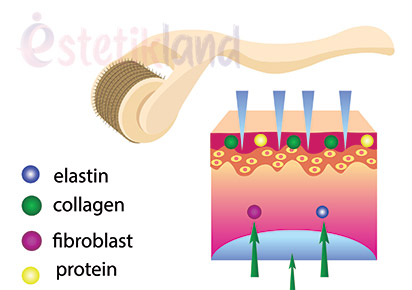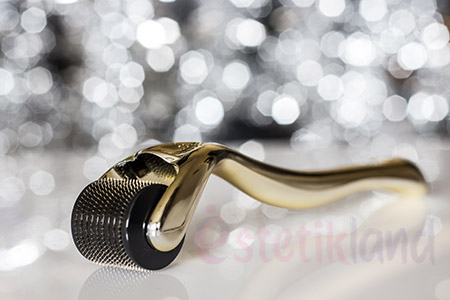Dermaroller is one of the treatments in the subgroup of micro-needling. Dermaroller opens channels on the skin with its rotating cylinder-shaped mechanism that contains micro needles (mm needles). Through the channels opened, the mineral, vitamin and protein structure that the skin needs is delivered under the skin.
These structures transmitted under the skin allow the skin to regenerate. The micro channels created during the procedure are perceived as wounds by the skin and the skin begins to repair and renew itself. In the natural wound healing process, collagen, elastin and hyaloronic acid production is triggered.
Thus, skin regeneration takes place in the problem area. Dermaroller needles can be found in different sizes, the needles are usually 0.75 mm and 0.5 mm in length.

Which areas can be implemented dermaroller?
This method, which helps to remove stain scars caused by scars and acne; It is also among the preferred techniques in the treatment of stretch marks, cellulite and sagging problems. Therefore, it can be applied to the areas with stretch marks, cellulite and sagging problems, face, neck, décolleté area, arms and hands.
How Many Sessions Are Applied?
In Dermaroller application, the needs of the skin structure of the person are determined and a treatment process ranging from 4 to 6 sessions is initiated.
Can Dermaroller Be Applied Every Day?
Dermaroller is not a treatment that is recommended to be applied every day. Here are the reasons why:
- Time for the Skin to Heal: Dermaroller stimulates collagen production by creating micro wounds on the skin. It is necessary to give the skin time to heal these micro wounds.
- Risk of Irritation and Inflammation: Applying a dermaroller every day can lead to constant irritation of the skin and potentially increased risk of infection.
- Excess Collagen Production: Stimulating collagen production by constantly stimulating the skin can lead to the formation of unwanted skin tissue over time.
- Weakening of the Skin Barrier: The skin’s natural barrier can be weakened by daily dermaroller application. This can cause the skin to become more vulnerable to external factors.
Which Vitamins are Used with Dermaroller?
Some popular vitamins and ingredients used with the Dermaroller are:
- Vitamin C (Ascorbic Acid): Known for its antioxidant properties, vitamin C can help brighten the skin and stimulate collagen production. It can also protect the skin against free radicals.
- Hyaluronic Acid: This ingredient can increase the skin’s capacity to retain moisture. It is often used after dermaroller to provide the moisture the skin needs.
- Vitamin E: Thanks to its antioxidant properties, it can prevent skin damage and accelerate healing.
- Peptides: Peptides, which stimulate collagen production, can be used with dermaroller for skin regeneration.
- Retinol (Vitamin A): Promotes skin regeneration and can help reduce the appearance of fine lines and wrinkles. However, it is important to note that retinol after dermaroller may cause skin irritation. Therefore, it is recommended not to use this combination without the advice of a dermatologist.
- B Vitamins (e.g. niacinamide): May strengthen the skin barrier, reduce redness and even skin tone.
What are the Benefits of Dermaroller Application?
- Regenerates damaged cells.
- Treats the signs of aging with its anti-aging feature.
- Purifies the skin from dead cells.
- Accelerates blood circulation.
- Eliminates stretch marks.
- Prevents cellulite formation. Removes existing cellulite.
- Eliminates acne, acne scars and skin blemishes.
- Provides a bright, vibrant and renewed skin.
- Helps maintain moisture balance in dry skin.
- It has the ability to treat under-eye bruises and bags.

Side Effects of Dermaroller
- Irritation: One of the most common side effects of the Dermaroller is skin irritation. After the treatment, a temporary irritation may occur at the application site.
- Redness and Swelling: After Dermaroller treatment, redness and mild swelling of the skin may occur. This usually subsides within a few days.
- Pain Tolerance: Each individual has a different pain tolerance. Some people may feel mild pain during and after the treatment.
- Sunburn-like condition: After treatment, the skin may show a sensitivity similar to sunburn. Therefore, sun protection is recommended after treatment.
- Interaction with Active Skin Problems: In individuals with active skin problems such as acne, herpes, eczema and psoriasis, Dermaroller application may worsen these problems.
- Inflammation: If the application is performed in unhygienic conditions, it can lead to inflammation that causes infection on the skin.
What Should Be Considered After Dermaroller Treatment?
The procedure is not a treatment method that will disrupt the patient’s daily routines. However, there are still some requirements to be considered during and after the treatment.
For example; it will be useful to use products containing vitamins and firming amino acids to strengthen the antiaging effect. If it is applied for stretch mark treatment, the application area should be supported by applying products containing collagen and amino acids, and the skin should be helped to regain its elasticity. Moisturizing cream should be applied to the application area at least 1 hour after the procedure.
Sun protection is one of the biggest requirements after the Dermaroller procedure. For this reason, if possible, sun exposure should be avoided during the procedure, and high-factor sunscreen creams should not be neglected when necessary.
The above mentioned service is provided as a consultancy service within Estetikland.
